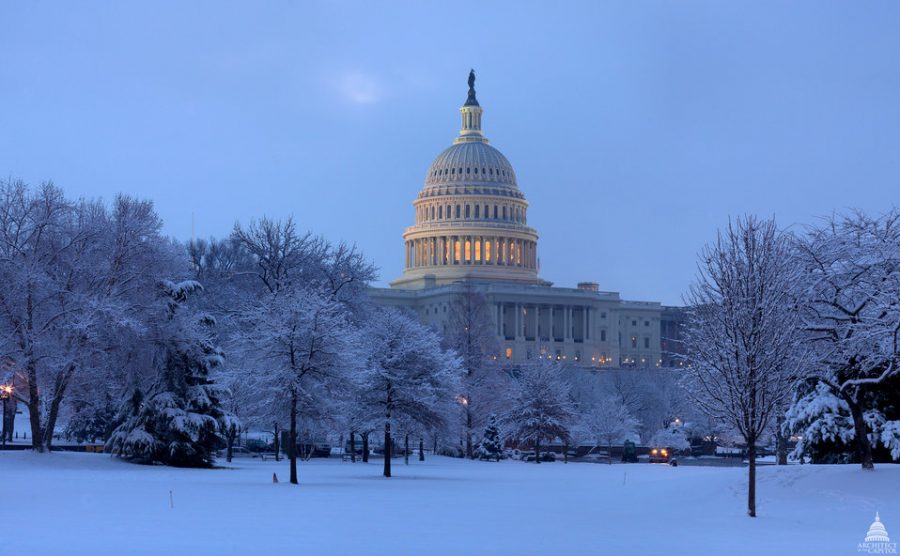Opinion: End government shutdown, let American workers work
As students here in Minooka, the government showdown 725 miles away in Washington, D.C., can seem distant and outlandish. So when social media references the partial government shutdown that’s been going on since Dec. 22, which may end up being the longest government shutdown in history since the 1995-1996 shutdown of 21 days, the details may just as well go in one ear and out the other.
But I want you to consider how this government shutdown hangs on President Donald Trump’s request for over $5.7 billion in border wall funding and the Democratic Party’s refusal to yield. I implore you to ask yourself whether this wall is worth the 800,000 government workers and their families scrambling to find alternative sources of income to make up for missed paychecks.
Whether this wall is worth what POLITICO calls workers clamoring for unemployment benefits, uncertainty for food stamp funding, hundreds of TSA call-outs, neglected national parks, and federal scientists missing crucial gatherings.
Whether it’s worth childcare costs weighing heavy on federal employees, landlords dipping into reserves, transportation progresses delayed, and courts barely scraping by to stay afloat.
Whether this $5.7 billion wall is worth an idle government in a time where new representation was elected into Congress to lead differently, propose bold ideas, and incite positive policy change for all Americans.
I implore you not to let this matter go in one ear and out the other.
The shutdown began after Trump and the Democrats on Capitol Hill failed to come to an agreement regarding whether to allocate funds to the president’s wall, most of Congress refusing to grant $5.7 billion to new federal spending legislation for a wall that won’t even cover 50 percent of the southern border and is not supported by 54 percent of the nation, according to a USA Today December poll.
Just hours before the start of the shutdown, Pennsylvania Rep. Mary Gay Scanlon tweeted a number of the various alternative uses for the $5.7 billion Trump is asking for a wall that the experts and most Americans agree is one of the most inefficient, ineffective, and costly means to address the so-called “humanitarian and security crisis”.
Scanlon told America $5 billion would cover the cost of repairing Puerto Rico’s power grid, medically assisted opioid treatment for over three-quarters of a million people, the cost of repairing Flint’s water system 90 times over, the salaries of school nurses for two years, Medicare prescription deductibles for 12.3 million seniors living in poverty, the cost to replace paperless voting machines all across this country 12 times, fund Planned Parenthood for a decade, among many other efforts.
On Tuesday evening, the 18th day of the government shutdown, Trump addressed the nation urging the American people to call their representatives and demand they fund his version of border security. On Jan. 8 leading up to the President’s speech at 8 p.m., “fact checking” became the phrase of the day. News sources across the country sent out articles that corrected Trump’s anticipated misleading and false statements that he would deliver throughout the address.
The mere notion that The Washington Post published a “fact checking cheat sheet” for the immigration address with the warning “if you are tempted to create a drinking game, however, we recommend you water down the drinks” reflects how the president’s history compels the public to assume his words are dishonest, and that in itself is beyond disconcerting.
Contrary to Trump’s claim that “the federal government remains shut down for one reason and one reason only: because Democrats will not fund border security,” The New York Times emphasized how Democrats have offered $1.3 billion in funding for border security measures like enhanced surveillance and fortified fencing, just not Trump’s wall.
The New York Times also discredited Trump’s assertion that the United States’ new trade deal with Mexico will pay for the wall as well as his context of illegal drugs smuggled across the border, which is mostly smuggled into the United States through legal ports of entry at the southern border — not through the desert, according to the Drug Enforcement Administration’s 2018 annual drug threat assessment.
Trump neglected to acknowledge that most immigrants he refers to as “illegal” are actually considered “inadmissible,” which refers to people who seek lawful entry into the United States but are barred from doing so. He also ignored the blatant fact that immigration spurs economic growth, a point argued vehemently by Mr. Kevin Hassett, the White House’s top economist who now serves on the Trump administration.
Speaker Nancy Pelosi and Senator Chuck Schumer delivered the Democratic response criticizing Trump’s refusal to pass bipartisan bills that would reopen the government and work toward alternative methods of border security — methods Democrats are more than willing to explore.
“The president just used the backdrop of the Oval Office to manufacture a crisis, stoke fear, and divert attention from the turmoil in his administration,” said Schumer. “The symbol of America should be the Statue of Liberty, not a 30-foot wall.”
It is not simply a partisan divide that keeps the shutdown in place, for many conservative government officials also regard Trump’s wall as a backward and futile approach to border security.
Texas Rep. William Hurd, for example, said, “I’ve made it clear time and time again that building a physical wall from sea to shining sea is the most expensive and least effective way to secure the border.” Additionally, the conservative Cato Institute has called Trump’s wall “impractical, expensive, and ineffective.”
One might also suspect that there are many more Republicans in office who would be more vocal against the shutdown if they weren’t afraid of alienating the right-wing GOP base.
A little over a week after the shutdown began, Massachusetts Senator Mitt Romney shook the Capitol by writing an op-ed for The Washington Post diminishing Trump’s the merit behind Trump’s character.
“To reassume our leadership in world politics, we must repair failings in our politics at home,” said Romney.” That project begins, of course, with the highest office once again acting to inspire and unite us. It includes political parties promoting policies that strengthen us rather than promote tribalism by exploiting fear and resentment.”
In response to Trump walking out of a border security negotiation meeting Thursday morning with the Democratic Party, Senator Susan Collins of Maine told NBC News, “It makes me very worried about whether we’re going to be able to get to a compromise this week. I’m worried about what the end game is. This cannot be allowed to go on forever.”
It most certainly cannot. Affecting over 800,000 federal workers in nine different departments (Agriculture, Commerce, Justice, Homeland Security, Housing and Urban Development, Interior, State, Transportation, and Treasury), as well as several federal agencies, federal workers deemed “essential” are required to work without pay. Others are furloughed, or placed on temporary leave, and are unlikely to receive compensation for their unwanted prolonged vacation.
A Department of Homeland Security confirmed that Jan. 8 was the last day to process federal paychecks, essentially guaranteeing their employees no pay come Jan. 11. The American Federation of Government Employees, which launched a recent lawsuit over the requirement that people are working without pay, called the requirement to work without pay “inhumane”.
From a bipartisan standpoint and from an American standpoint, an end to this shutdown is necessary, and it is necessary now. Workers who are living paycheck to paycheck will be unable to support themselves their families without the pay to which they are entitled.
Perhaps the best illustration of this irony involves the Secret Service as Trump’s very own bodyguards will be protecting him without pay come Jan. 11 as he refuses to act in the best interest of the nation and give up his desperate effort to fulfill a broken campaign promise.
Trump used the esteemed Oval Office address irreverently, “manufacturing” a crisis and attempting to instill an aura of fear within U.S. citizens where no such extreme danger exists. Threatening to declare a state of national emergency at our southern border, Trump forgets the national emergency he created since this shutdown began.
“I think that would be a very dubious move from a constitutional perspective,” said Collins in reference to Trump alluding to a state of national emergency. “Without congressional authorization, it’s not what I think is intended by the National Emergency Act.”
The course of action is simple: Trump must swallow his pride and end the shutdown, ensure just compensation for federal workers, and allow the border security discussion to persist in Congress where both parties can reach a more viable alternative than the divisive and counterproductive wall.
“Separate the shutdown from arguments over border security,” said Schumer. “There is bipartisan legislation supported by Democrats and Republicans to reopen the government while allowing debate over border security to continue. There is no excuse for hurting millions of Americans over policy difference.”
A wall will never be worth the havoc it has already wrought upon our nation, and construction has not yet even begun.








